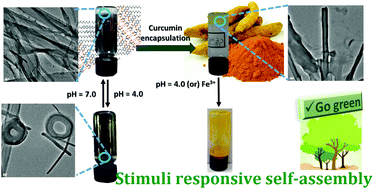Stimuli responsive hydrogels derived from a renewable resource: synthesis, self-assembly in water and application in drug delivery†
Abstract
We designed and synthesised coumarin-tris derivatives from a renewable resource and well characterized them using different spectral techniques. The self-assembly of coumarin-tris amphiphiles into hydrogels was examined relative to the molecular structure of the amphiphiles. The reversible morphological transition from nanofibers to vesicles and nanotubes has been observed, upon pH variation. Reversible processes and self-assembled structures such as gel, vesicle and nanotube formation have been investigated using optical microscopy and high resolution transmission electron microscopy (HRTEM). 1H NMR and XRD studies clearly suggest that the π–π stacking interactions and hydrogen bonding were the driving force for the process of gelation. The flow behaviour of the hydrogel has been identified using rheological measurements. More importantly, the chemopreventive drug curcumin has been encapsulated into the gel and subsequent release has been achieved by a gel-to-sol transition induced by pH and Fe3+ metal ion stimuli. The reported hydrogel could play a substantial role in the development of new generation stimuli responsive drug delivery systems for in vivo formulations.



 Please wait while we load your content...
Please wait while we load your content...